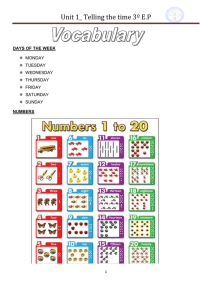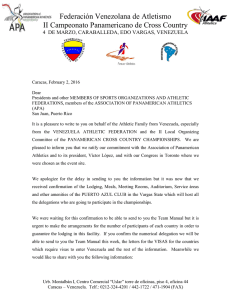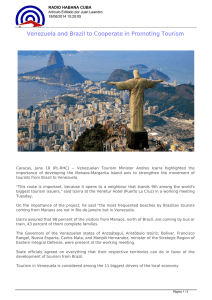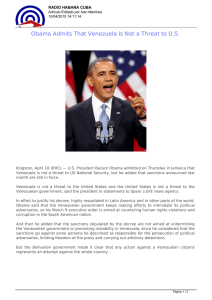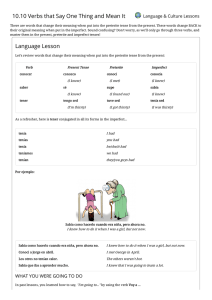cancion de protesta en Venezuela - prof.usb.ve.
Anuncio
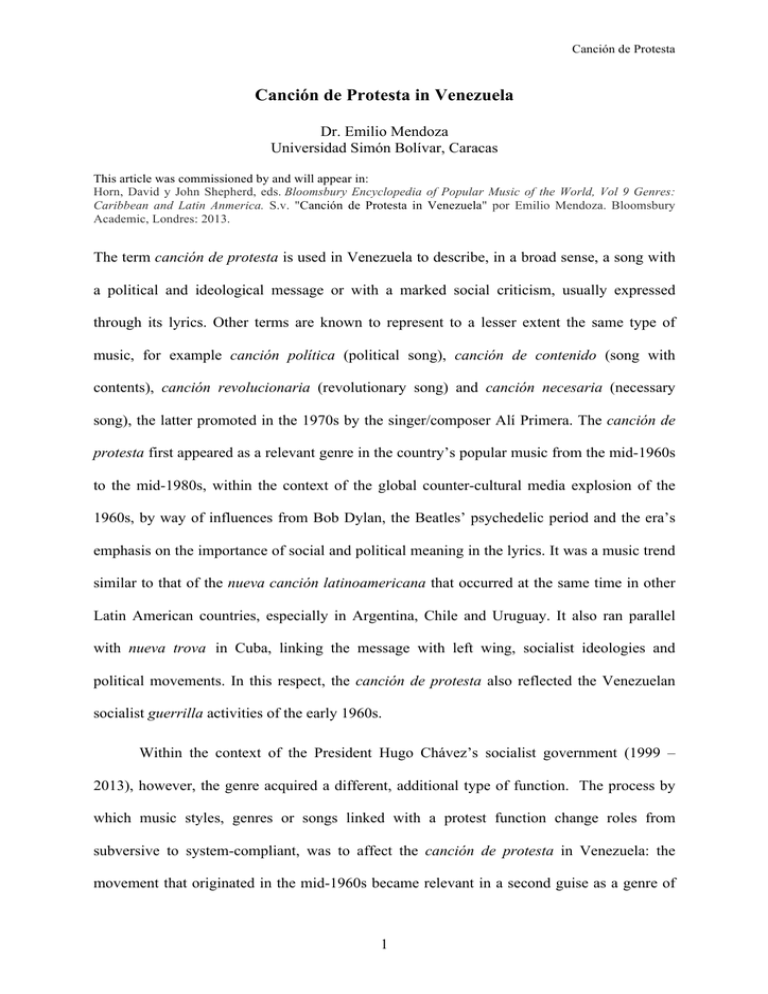
Canción de Protesta Canción de Protesta in Venezuela Dr. Emilio Mendoza Universidad Simón Bolívar, Caracas This article was commissioned by and will appear in: Horn, David y John Shepherd, eds. Bloomsbury Encyclopedia of Popular Music of the World, Vol 9 Genres: Caribbean and Latin Anmerica. S.v. "Canción de Protesta in Venezuela" por Emilio Mendoza. Bloomsbury Academic, Londres: 2013. The term canción de protesta is used in Venezuela to describe, in a broad sense, a song with a political and ideological message or with a marked social criticism, usually expressed through its lyrics. Other terms are known to represent to a lesser extent the same type of music, for example canción política (political song), canción de contenido (song with contents), canción revolucionaria (revolutionary song) and canción necesaria (necessary song), the latter promoted in the 1970s by the singer/composer Alí Primera. The canción de protesta first appeared as a relevant genre in the country’s popular music from the mid-1960s to the mid-1980s, within the context of the global counter-cultural media explosion of the 1960s, by way of influences from Bob Dylan, the Beatles’ psychedelic period and the era’s emphasis on the importance of social and political meaning in the lyrics. It was a music trend similar to that of the nueva canción latinoamericana that occurred at the same time in other Latin American countries, especially in Argentina, Chile and Uruguay. It also ran parallel with nueva trova in Cuba, linking the message with left wing, socialist ideologies and political movements. In this respect, the canción de protesta also reflected the Venezuelan socialist guerrilla activities of the early 1960s. Within the context of the President Hugo Chávez’s socialist government (1999 – 2013), however, the genre acquired a different, additional type of function. The process by which music styles, genres or songs linked with a protest function change roles from subversive to system-compliant, was to affect the canción de protesta in Venezuela: the movement that originated in the mid-1960s became relevant in a second guise as a genre of 1 Canción de Protesta mixed popular music that shared some characteristics with the songs of the first countercultural period, but was no longer an expression of a minority in disagreement with the Establishment, rather a tool in a complex machinery for the perpetuation of the ideology and power of the ruling system within Chavez’s regime. In this process, the songs of the late Alí Primera achieved higher media exposure than they had during his lifetime, and the canción de protesta was adopted as a characterization in sound of the ‘Bolivarian revolution’ of Chávez and manipulated in the hands of the regime as a mass-gathering device for left-wing political propaganda. This development was different to the eventual and expected absorption of this type of music into the Establishment by way of the media industry, an inherent contradiction characteristic of the genre of protest songs overall when they become involved with the music industry. An important antecedent of Venezuelan canción de protesta is found in the canciones patrióticas (patriotic songs) that were used by the revolutionary movements in Caracas around 1811 seeking independence from Spanish rule. They are exemplified by ‘Gloria al bravo pueblo’ (Glory to the Brave People) (music by Juan José Landaeta and text by Vicente Salias), an insurgent song that was officially declared the Venezuelan National Anthem in 1881 by the President Antonio Guzmán Blanco, and must be sung every morning in all schools and heard at midnight in all radio and television stations of the country. The canción revolucionaria is considered by the musician Daniel Gil to include anthems of communist movements and organizations in the world, songs from the Spanish Civil War and the Mexican Revolution, and songs of political prisoners (see the CD Antología de la Canción Revolucionaria [Anthology of Revolutionary Song] [2007], which contains two songs adopted by Venezuelan political prisoners of the 1960s and 1970s as their anthems, ‘Bandoleros’ and ‘Himno del Calabozo’). 2 Canción de Protesta It also needs to be considered that political movements and parties in Venezuela have extensively used short songs as effective propaganda during the elections, in close similarity to the canción de protesta., as well as longer songs as their anthems. The thin line between canción de protesta and propaganda changes with the historical and functional context in which it appears, and of course there are other types of music with no text that imply.protest by its reiterated use in marches and rallies, such as particular rhythms performed by hitting cooking pans or cacelorazos on the streets: 4/4 aprox. 94 bpm q q e e q and e e q e e q The First Period (1960s-1985) In the first period of the canción de protesta in the mid-1960s, two different types of popular musicians can be identified as belonging to the genre: the singer-composer, who was usually also a political activist, and the singer-only type of musician, who was involved in the musical and political activities of the times but changed genres thereafter with the coming trends. The most important examples of the first type, the singer-composer, are Alí Primera, Gloria Martín and Xulio Formoso. Primera and Martín wrote the lyrics to their songs, while Formoso worked closely with political poets such as Farruco Sesto. The center of activity of the canción de protesta was based in the country’s universities where concerts, rallies and marches took place. The singers also attended national and international song festivals, usually competing with a specific title to win a prize and the corresponding media recognition. Gloria Martín also composed cantatas and Formoso was also involved in composing music for the theater. 3 Canción de Protesta By far the most influential personality in the first period of the canción de protesta was the singer and composer Alí Primera, whose singing career, which began in1967, ended suddenly in a car accident in 1985. His style of music, developed as a student in the Universidad Central de Venezuela, Caracas, featured his voice with the guitar or cuatro, folk elements (instruments, rhythms and genres) and hybrid ensembles of his own configuration consisting of folk and symphonic instruments. His large output of songs included over fourteen albums. Primera called his music canto necesario (necessary song/singing), expressing the idea that he was not only a singer of the political left, but a singer for all the poor people. He was an intense, national political activist and member of three Venezuelan communist parties. He created his own record label Cigarrón in 1977 for promoting his music as well as for new talents, after established record labels, radio and TV stations banned his production. The music of Primera carried a mix of Bolivarian messages of unity, left-wing ideology, Cuban sympathy, anti-USA slogans, folk values of the regions of the country, and love. From his first solo album Lo primero de Alí Primera in 1973 until his last Entre la rabia y la ternura in 1984 (Between Rage and Tenderness), his work included many hits, such as ‘Canción mansa para un pueblo bravo’ (Tame Song for a Brave/Angry People) (1984). He also dedicated his work to popular poets, painters and social activists such as Aquiles Nazoa and Cesar Rengifo, among many others. The other important singer-composers of that period within the canción de protesta movement of Venezuela were two Spanish-born artists who arrived in Venezuela while still young. Gloria Martín was very active in national and international festivals from 1969 until 1992, as well as in social-cultural activities, writing songs and mixed-media works such as the Cantata a Fabricio Ojeda in 1977, and later becoming a university professor and author. Xulio Formoso started in 1970 with six canciones de protesta in the record Galicia canta, in the Galician language (the first recording of sung Galician poetry made in Latin America), 4 Canción de Protesta and established the nueva canción gallega (Galician New Song), with texts by Farruco Sesto and Celso Emilio Ferreiro. He produced the music for a successful political theater work by Antonio Miranda, Tu país está feliz (Your Country is Happy) in 1971, and a series of ten albums of his songs with texts in Spanish by Farruco Sesto among other political poets. In 1978 Formoso abandoned his singing career to become a systems engineer. Under Chávez’s presidency, Sesto was appointed the Venezuelan Cultural Minister in 2005 and since 2007 Formoso has led CENDIS, the national center for the production of compact discs. In such positions, as employees of the socialist government, Formoso and Sesto have continued with the left-based political beliefs that they had jointly expressed earlier through canciones de protesta, and in 2002 they joined forces again to produce Formoso’s CD, En el J.B. Plaza. A large number of followers of the revolutionary trend in the 1960s belonged to the second type of musicians identified earlier, that of the singer-only, the main figure being Soledad Bravo. Of Spanish origin, arriving in Venezuela as a child, she appeared in 1968 as a singer within the movement centered at the Universidad Central de Venezuela in Caracas. Her first recording (Soledad Bravo canta) was an album that included Spanish and García Lorca songs of the Spanish Civil War. On her second album in 1969 (Soledad), she included a repertoire of canciones de protesta and in 1973 she made an all-nueva trova album, Canciones de la nueva trova cubana. In 1974, however, she turned to a neofolklore repertoire (urban arrangements of traditional folk music), following the awakening folk trend of the grupos de proyección (folk music performed by recording artists and professional music groups, sounding as close as possible to the original). Bravo has developed an extensive and important international career as a singer, characterized by continuously changing styles and genres. The Second Period (1999-2013) 5 Canción de Protesta Since 1999, with the arrival of ‘Chavismo’ in Venezuela, the figure of the socialistrelated singer Alí Primera became the cantor del pueblo (singer of the people), and also generally - though the term was not exclusive to this type of music - cantautor (singerauthor). This second cycle of the canción de protesta in Venezuela originated as part of a revolutionary-tagged government following in Cuba’s footsteps, but 40 years later. Alí Primera’s songs and iconography were extensively used in the media, in a similar way to the recycling of the famous Che Guevara photographs of the 1960s, to promote governmental policies and communist ideology, and to acquire support mainly from the poorest segments of the Venezuelan society, which account for 80% of the country’s population. Primera’s music and concepts fitted perfectly within Chávez’s Bolivarian revolution and served for the construction and promotion of value objects and symbols. Although Primera died almost 15 years before the Chávez era, and had been remembered to that point mainly via sporadic homage concerts, he became nationally famous again in the early twentyfirst century through the governmental use of the same recordings of his songs that he had produced in the earlier counter-cultural times. This was achieved by means of a governmentestablished network of community television and radio stations as well as the main television channels that, with one exception, were all controlled by or were in compliance with the government. Other newcomers have since been promoted through the television and have gradually extended the canción de protesta repertoire to include any folk or pop genre, especially rock, reggae and hip-hop. These include the revised grupo de proyección Madera, and new singers and groups, all in different mixed styles from romantic ballad to salsa, to represent the new pro-government canción de protesta. In 2006, Madera produced the salsa banner-song for rallies in support of Chávez, ‘Uh, ah, Chávez no se va’ [Uh, Ah, Chávez is not leaving]. Cantora del pueblo Hanoi has reached exposure through the government television channel 6 Canción de Protesta VTV Canal 8 with her video ‘Aquí andamos’ (Here We Go), proclaiming the Bolivarian revolution, as has the romantic Gustavo Arreaza with his revolutionary theme ‘La verdad’ (The Truth). Since 2007, the music group Dame Pa’ Matala (which literally means: pass me the joint to smoke to its end), with a mixture Caribbean music and hip-hop influences, has made music with national and Latin American ‘contenido’ (contents), featuring “…messages of peace, unity and conscience-awakening…,” and are one of the favourite groups of the regime’s media stations. In the group’s most recent music and video production Movimiento Latino (Latin Movement) of 2013, the promotional song ‘Piel sin silicón’ (Skin Without Silicon) criticizes the wide extent of beauty surgery among contemporary Venezuelan women. This new development, after 14 years of socialist canción de protesta ‘imposed’ by the government, marks a definite change, with groups choosing to continue with a critical edge but no longer obliged to do so within the politics of left and right. On the other side, hip-hop in the hands of Leonardo Viloria “NK Profeta”, author of the nation-wide video made in 2009, Documental de hip hop de Venezuela (Documentary of Hip-Hop in Venezuela), has become a major vehicle for dissent against the government. In 2010 NK Profeta created a controversial song ‘Sr. Presidente’ (Mr. President) which attracted much media attention in Venezuela and in El Nuevo Herald of Miami, FL. Apart from his national and international concerts, NK Profeta performs live during political rallies against the regime in Caracas. In Chávez’s bombastic burial ceremony after his death on the March 5, 2013, many musicians performed live by the side of the coffin, their repertoire consisting mainly of joropo music with political texts, and songs from Alí Primera. Florentino Primera’s son, chose to sing his father’s ‘Canción en dolor mayor’ (Song in Major Pain) for the event. For 7 Canción de Protesta seven days after Chavez’s death, radio stations were allowed to play classical music and Alí Primera’s songs. Other genres of popular/folk music in Venezuela carry a protest or critical message in their texts, but do not serve this function exclusively and were not part of the counter-culture movement of the 1960s. Traditionally, joropo llanero music (triplet–based folk music from the flat-land region performed with diatonic harp, a small guitar called the cuatro, maracas and voice), places a high prominence on the lyrics and the singer’s ability to improvise them with philosophical turns, so it has invariably included protest meanings in its long existence, responding to contextual, political and economical problems abundant in the country. The same applies to joropo oriental (a type of joropo from the eastern part of the country performed with mandolins, cuatro, guitar, maracas and voices), especially with Francisco Mata y sus Guaiqueríes of the Margarita Island, and with many gaita productions at Christmas time (folk music genre from the Zulia state). In a country drastically split in two halves between those who are for and those who are against the Chávez government, artists take sides and some joropo singers have formed part of the government’s promoting forces, as did Cristóbal Giménez with his release Amor, llano y revolución (Love, Flat-lands and Revolution) in 2004, while on the other side the anti-Chavez songs of Reynaldo Armas, have been banned from the media. Rock sung in Spanish has provided social criticism among other themes, especially in the leading figure of Pedro Vicente Lizardo (PTT) with his group La Misma Gente, who from 1967 have continued without interruption to produce a large number of songs independently of the changing movements in music, for example ‘Esperando el autobus’ (Waiting for the Bus). Perhaps as a result of the overwhelming, sustained and long exposure of the Chávez personality-cult in the media, with the included promotion of his “revolution” another canción de protesta is emerging in Venezuela as a reaction to this state of left-political saturation. Different genres are involved, such as hip-hop, rock and reggae, 8 Canción de Protesta but in this parallel line of development, the music is characterized by a global sense rather than the previous left-right political antagonism linked with socialism, as can be seen for example in the music of the successful Venezuelan reggae group Papashanty Saundsystem with ‘Música de paz’ (Peace Music). Bibliography Doffiny, Felipe. 1998. ‘Gloria Martín.’ In Enciclopedia de la música en Venezuela. Vol. 2., eds. José Peñín and Walter Guido. Caracas: Fundación Bigott, 185. Doffiny, Felipe. 1998. ‘Soledad Bravo.’ In Enciclopedia de la música en Venezuela. Vol. 1. , eds. José Peñín and Walter Guido. Caracas: Fundación Bigott, 220-21. Fundación Vicente Emilio Sojo. N.d.Catálogo discográfico de intérpretes y compositores venezolanos [Discographical Catalogue of Venezuelan Performers and Composers]. Online at http://www.catalogofunves.org.ve Galicia Canta. 2004. 34 Anos de música galega en Sudamérica. Online at http://www.ghastaspista.com/historia/gzcanta.php López Cortés, Eliseo and Becerra González, Rubén Armando. 2007. Cultura y contracultura, redes y poder [ Culture and Counterculture, Networks and Power]. Ocotlán, Jalisco: Universidad de Guadalajara. López Cortés, Eliseo and Hurtado, Javier. 2003. El rock del siglo XX: Entre la contracultura y el poder de la industria cultural [Twentieth-Century Rock: Between the Counterculture and the Power of the Cultural Industry]. . Ocotlán, Jalisco: Universidad de Guadalajara. Martín, Gloria. 1992. Metódica y melódica de la animación cultural [Method and Melody of Cultural Entertainment]. Caracas: UCV. Martín, Gloria. 1994. De los hechizos de Merlín, a la píldora anticognitiva [From the Spells of Merlin to the Anti-Cognitive Pill]. Caracas: Alfadil. Martínez Crespo, Xurxo. 2004. ‘34 Anos de Música Galega en Sudamérica.’ Confederación Intersindical Galega. http://www.galizacig.com Miranda, Antonio. 2004. Xulio Formoso. (Online at http://www.antoniomiranda.com.br/xulio_formoso/xulio_index.html) Ocanto, Casto. 17-02-2010. ‘Critican a Chávez a ritmo de hip-hop.’ El Nuevo Herald Boletín América Latina. (On line at http://www.elnuevoherald.com/2010/02/17/655192/se-populariza-un-rap-contrael.html). 9 Canción de Protesta Peñín, José. 1998. ‘Himno nacional de Venezuela’ [National Hymn of Venezuela]. In Enciclopedia de la Música en Venezuela. Vol. 1,. eds. José Peñín and Walter Guido. Caracas: Fundación Bigott, 734-35. Rincón, Carlos, and Schattenberg-Rincon, Gerda, eds. 1978. Cantaré, Songs aus Lateinamerika. Berlin: Verlag Neues Leben. Salazar, Rafael. 1986. Música y folklore de Venezuela. Caracas: Ed. Lisbona-Fenacup. Salazar, Rafael. 1998. ‘Alí Primera.’ In Enciclopedia de la Música en Venezuela. Vol. 2 , eds. José Peñín and Walter Guido. Caracas: Fundación Bigott, 479-80. Síncopa. 2002-2008. Síncopa: The Guide to Venezuelan Music. Online at http://sincopa.com Strauss, Rafael, ed. 1999. Diccionario de la cultura popular. Vol. 1. Caracas: Fundación Bigott. (Contains entries for Soledad Bravo, Gloria Martin, Francisco Mata, Alí Primera, 579-81. Venezuelatoda. 2006. Venezuelatoda. Online at http://www.venezuelatoda.org.ve Discographical References Bravo, Soledad. Canciones de la nueva trova cubana. Promus 24 80 251. Polydor 30286. 1973: Venezuela. Bravo, Soledad. Soledad Bravo Canta. Discos América LPA 2017. 1968: Venezuela. Bravo, Soledad. Soledad. Discos América-Promus LPA 2026. 1969: Venezuela. Dame Pa’ Matala. ‘Piel sin Silicón,’ Movimiento Latino. DPG Producciones. 2013: Venezuela. Formoso, Xulio and Sesto, Farruco. ‘Cholo Peruán,’ ‘Pandeirada ao Che,’ Galicia Canta. Pobovox de Caracas. 1970: Venezuela. Formoso, Xulio. En el J.B. Plaza - Julio 2002. Independent Production. 2002: Venezuela. Formoso, Xulio. Tu País está Feliz. Souvenir LP 6294. 1971: Venezuela. Gil, Daniel. ‘Bandoleros,’ ‘Himno del Calabozo,’ Antología de la Canción Revolucionaria. PDVSA FD2522006422. 2007: Venezuela. Giménez, Cristóbal. Amor, llano y revolución. Independent Production. 2004: Venezuela. La Misma Gente. ‘Esperando el autobús.’ Somos Todos. Cacao Música. FD43120071028. 2008: Venezuela. 10 Canción de Protesta Martín, Gloria. ‘Cantata a Fabricio Ojeda.’ Cantata a Fabricio Ojeda - Cantos de Lucha de la Revolución Venezolana. Movieplay – Gong. 1977: Spain. Papashanty SaundSystem. ‘Música de Paz.’ Ashanty Grampa. Granpa Music FD2522005124. 2003: Venezuela. Primera, Alí. Canción Mansa para un Pueblo Bravo. Promus/Cigarrón LP-003. 1978: Venezuela. Primera, Alí. Entre la rabia y la ternura. Cigarrón LPCS-0028. 1984: Venezuela. Primera, Alí. Lo primero de Alí Primera. Cigarrón-Promus. 1973: Venezuela. Discography Bravo, Soledad. Cantos de Venezuela. Polydor 30281. 1974: Venezuela. Formoso, Xulio. Amantes de Ningún Lugar - Sobre Textos de Farruco. Agua Mansa LPS.001. 1978: Venezuela. Hanoi. Echa Andar. Independent Production. 2006: Venezuela. Martín, Gloria and Sosa, Mercedes. Si se Calla el Cantor. Philips - 40.032. N/y: Venezuela. Martín, Gloria. Para este País - Cantos de Lucha de Venezuela. 1976: Spain. Mata, Francisco. Francisco Mata 76 y Sus Guaiqueríes Auténtica Música Margariteña. Discomoda DCM-961. 1976: Venezuela. Primera, Alí. Al Pueblo lo que es del César Vol. XI. Cigarrón LPCS-0022. 1981: Venezuela. Primera, Alí. Cuando nombro la Poesía. Al entrañable recuerdo de Aquiles Nazoa. Promus/Cigarrón LP-009. 1979: Venezuela. Music Videos and Youtube Clips Arreaza, Gustavo. La Verdad (Music Video). VTV Canal 8. 2007: Venezuela. http://www.youtube.com/watch?v=5hUmY4jtkFY Dame Pa’ Matala. Piel sin Silicón (Music Video). DPG Producciones. 2013: Venezuela. http://www.damepamatala.com.ve/ Grupo Madera. Uh, Ah, Chávez no se va (Music Video). VTV Canal 8. 2006: Venezuela. http://www.youtube.com/watch?v=H5wr5BQGDLI http://www.youtube.com/watch?v=2Ma8Z4vOkmk 11 Canción de Protesta Hanoi. Aquí Andamos (MusicVideo). VTV Canal 8. 2006: Venezuela. http://hanoicantora.com/video.html http://www.youtube.com/watch?v=ABn-E_OOYxA Websites Hanoi. 2006. Hanoi su Canto. http://hanoicantora.com/index2.html La Misma Gente. 2007. La Misma Gente. http://www.myspace.com/lamismagentevenezuela NK Profeta. 2012. NK Profeta http://www.nkprofeta.com Pacoweb. 2008. Pacoweb. http://pacoweb.net Papashanty SaundSystem. Papashanty SaundSystem. www.papashanty.com 12

